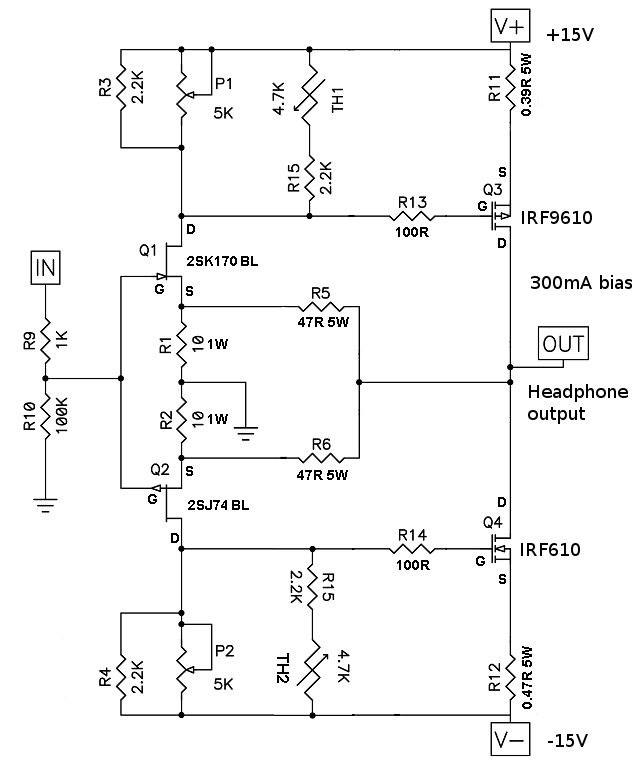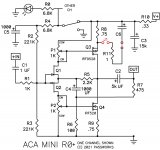I was wanting for this question 😀I know it would complcate the design and raise costs but... could the single ended supply be changed to a bipolar supply? And in so doing connect C4 to ground and omit C2? Would that work?
It seems that it should. Does anyone more knowledgabla than me have any thoughts on this?
It remembered me the B1 years...
Metal fabrication is cheap nowadays. I had this PSU enclosure laser cut from 1.2mm steel and powder coated for the equivalent of 41.00 US$.

.
.

.
.
Can the IRF9520, IRF520 MOSFETs, from Vishay or Infineon, be used for this amp? or do we only need the MOSFETs from Harris corp only?
Next step is to put the mini into my main system and compare it to the VFET amplifier. For now, I am too much in love with the VFET to take it out of the system. It does seem worth making the comparison as I don't know how many of us were lucky twice, in the VFET lottery and the BAF 2021 giveaway.
Can the IRF9520, IRF520 MOSFETs, from Vishay or Infineon, be used for this amp? or do we only need the MOSFETs from Harris corp only?
I am sure you can use IRF9520, IRF520 from Vishay or Infineon!
🙄With great good fortune comes great responsibility!
hayenc;6866063 said:It does seem worth making the comparison as I don't know how many of us were lucky twice, in the VFET lottery and the BAF 2021 giveaway.
Last edited by a moderator:
Franz is correct. The specific manufacturer is not critical it all.
but matching is? in terms of having fun with the "distortion jumpers", it surely will sound good either way : )
tnx,
stefan
Next step is to put the mini into my main system and compare it to the VFET amplifier. For now, I am too much in love with the VFET to take it out of the system. It does seem worth making the comparison as I don't know how many of us were lucky twice, in the VFET lottery and the BAF 2021 giveaway.
You'll be surprised! I guarantee it.
but matching is? in terms of having fun with the "distortion jumpers", it surely will sound good either way : )
tnx,
stefan
Matching Shouldn't matter. You adjust the bias of each MOSFET to the suggested bias in the writeup. Getting a couple of each MOSFET from the same.source like mouser etc most likely means you'll get them from the same batch anyways.
Can the IRF9520, IRF520 MOSFETs, from Vishay or Infineon, be used for this amp? or do we only need the MOSFETs from Harris corp only?
Traditionally the Harris are the premium part, especially for the lack of the "P channel distortion" of the IR parts, as documented in my old article on testing mosfets, posted at FIRST WATT.
More recently I have seen some samples of IR (Vishay) P channel parts without it, but it is random and not clear what difference in sourcing accounts for it, in spite of request for such information.
So if you are in a position to test parts before buying or if you apply plenty of feedback or don't care then you can go ahead. I find it simply easier to buy the nos Harris parts much of the time, particularly for Common Source operation with low feedback.
Traditionally the Harris are the premium part, especially for the lack of the "P channel distortion" of the IR parts, as documented in my old article on testing mosfets, posted at FIRST WATT.
More recently I have seen some samples of IR (Vishay) P channel parts without it, but it is random and not clear what difference in sourcing accounts for it, in spite of request for such information.
So if you are in a position to test parts before buying or if you apply plenty of feedback or don't care then you can go ahead. I find it simply easier to buy the nos Harris parts much of the time, particularly for Common Source operation with low feedback.
Hi Sir, thanks for the detailed info.
Also could you please tell, whether we can use the JFETS 2SJ103-GR & 2SK246-Y , for Q1 and Q2, in mini ACA. If yes, will it have lesser gain/output power ?
And does these two JFETs and output MOSFETs needs to be matched.
Last edited:
With slight rearrangement of parts we can mitigate some of the notorious audiophile fears that arise in this lovely circuit - trading places of C4/R6 enables us to introduce second feedback loop (R7/R6) which encompasses both feedback cap C4 and output coupling cap C2 (which now can be of smaller value, say 4,700uF) so that cap's influence on the amp's sound will be constrained. Also, R5 changes value to 2k2 and R7 to 470 (475) Ohms.
Easy trick to try...
Easy trick to try...

Attachments
Last edited:
Great idea to include caps in a nfb loop!
Anything against going back to F5 symetric psu?
Would it be the same result?

Anything against going back to F5 symetric psu?
Would it be the same result?
- Home
- Amplifiers
- Pass Labs
- DIY ACA mini
